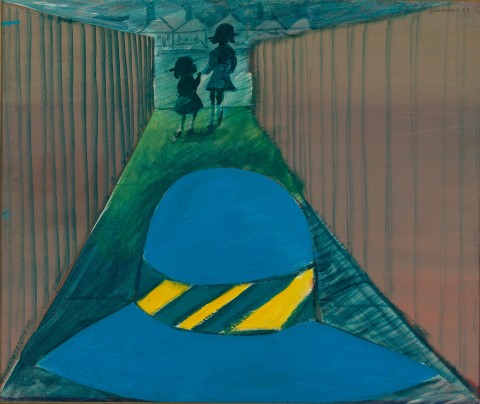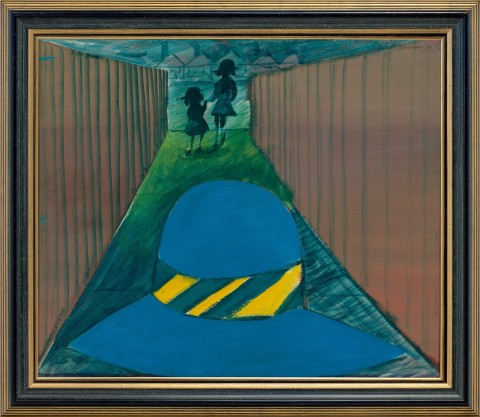SCHOOLGIRL’S HAT, 1953
CHARLES BLACKMAN
oil on cardboard on particle board
63.0 x 76.0 cm
signed and dated upper right: BLACKMAN 53
Private collection
Christie’s, Melbourne, 24 November 1992, lot 239
Private collection, Melbourne
Private collection, Melbourne, acquired from the above
Heads & Bodies, Charles Nodrum Gallery, Melbourne, 1 – 17 March 2018
Schoolgirls in passage, 1952, charcoal on paper, 61.0 x 76.0 cm, in the collection of the National Gallery of Australia, Canberra
Imbuing the playful innocence of childhood with an underlying menace informed by contemporary events, Charles Blackman’s Schoolgirls represented the first truly unique visions to emerge within his painting and as such, were pivotal in establishing his reputation as an artist of great individuality. Indeed, from their inaugural unveiling at Peter Bray Gallery, Melbourne in 1953 – a classic succès de scandale – his surrealist-inflected depictions such as Schoolgirl’s hat, 1953 have become legendary in the public imagination; as art critic for The Herald, Alan McCulloch, effused at the time: ‘...the artist has projected his personality, with all its hopes and frustrations, into the extremely difficult subject of the schoolgirls… [the paintings] speak aggressively, perhaps, but with undeniable power and artistry… In the hands of merely the competent painter such a subject would be ludicrous. In Blackman’s hands, John Shaw Neilson’s schoolgirl becomes a creature of endless aesthetic possibilities… at once exciting and extremely stimulating.’1
Commenced in 1952 following Blackman’s move to Melbourne the previous year, the Schoolgirl series was inspired initially by the reality of the artist’s new environment – the neighbourhood of Hawthorn where, travelling to and from his coach-stable studio, uniformed schoolchildren were a daily sight. More profoundly however, the series also resonated with his underlying fear of isolation, a fear that was poignantly reawakened by the recent murder of Betty Shanks, a university friend of Barbara’s, in Brisbane in 1952, as well as the notorious murder of a schoolgirl near Melbourne’s Eastern markets some thirty years earlier – ‘the jagged, savage image that childhood is alone’2 having a profound and anguished effect on him. With their tenderness and lyricism, such images also reveal Blackman’s insight into the female psyche – a legacy of vivid childhood memories of his mother and sisters that was revived by his reading of the literature of childhood fantasy, particularly French novels of adolescent eroticism such as the Claudine schoolgirl series by Colette. Interestingly, it was not until well after Blackman had embarked upon the theme that he encountered the John Shaw Neilson schoolgirl poetry to which his work is often compared. Admiring especially the semi-blind poet’s emotional use of colour, Blackman found the mystical verse ‘very akin to what I felt myself in some sort of way... the frailty of their image, as such, and their being a kind of receptacle... of very delicate emotional auras.’3
Occupying a realm between dream and reality, Blackman’s Schoolgirls present a myriad of emotional states and entities – from vulnerable and self-absorbed to dangerously clumsy, haunting and even predatory. In the present work, the pervading mood is one of uneasy disquiet or foreboding, heightened not only by the scale discrepancy between the oversized school hat and its surrounds, but by the enigmatic silhouettes of the two lone schoolgirls who, walking side-by-side holding hands, flee down the dark alleyway towards some safe destination – or their impending doom. Alone and defenceless in an environment that threatens in its obscurity – empty of protection, and full of the unknown – thus the figures encapsulate the artist’s own inner emotions of vulnerability that had inspired his identification with the Schoolgirl theme in the first instance: ‘…The Schoolgirl pictures had a lot to do with fear, I think. A lot to do with my isolation as a person and my quite paranoid fears of loneliness and stuff like that; indeed, you could almost say that’s why I painted them.’4
1. McCulloch, A., ‘Quantity and Quality’, The Herald, Melbourne, 12 May 1953
2. Charles Blackman, cited in Amadio, N., Charles Blackman: The Lost Domains, A.H. & A.W. Reed Publishing, Sydney, 1980, p. 14
3. Charles Blackman in an interview with Thomas Shapcott, 6 September 1966, cited in St John Moore, F., Charles Blackman: Schoolgirls and Angels, National Gallery of Victoria, Melbourne, 1993, p. 6
4. Charles Blackman, cited in Shapcott, T., The Art of Charles Blackman, Andre Deutsch, London, 1989, p. 11
VERONICA ANGELATOS


